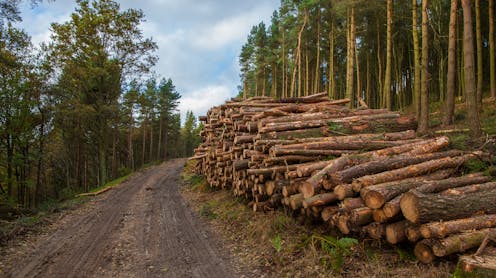Detta inlägg post publicerades ursprungligen på denna sida this site ;
Date:
Author: John Healey, Professor of Forest Sciences, Bangor University
Original article: https://theconversation.com/uk-must-grow-more-of-its-own-wood-to-meet-climate-goals-new-research-254353
Wood is often hailed as a low-carbon hero, a natural alternative to steel, concrete and plastic. It’s a vital tool in the UK’s strategy for reaching net zero. But there’s a catch – the country don’t grow nearly enough of it.
The UK has one of the lowest levels of forest cover in Europe, with just 14% of land forested. It is also the second-largest importer of wood in the world, meeting only 20% of its wood demand from domestic sources.
That leaves the UK not only exposed to volatile global markets, but also facing a serious challenge of “wood security”. And our new research shows the problem goes well beyond economics.
Relying heavily on imported timber, especially from boreal forests in Scandanavia and the Baltic States, could actually undermine the carbon-cutting benefits of using wood in place of high-emissions materials.
Boreal forests occurring in colder northerly environments grow slowly. The carbon stored in them takes decades, sometimes centuries, to recover after harvesting through the growth of the next generation of trees.
In contrast, conifer forests in the UK’s warmer temperate climate restock carbon through regrowth more quickly after harvesting. This makes them much better suited for higher yields of sustainable wood production.
So, how can countries such as the UK increase wood use without making the climate crisis worse? To address this, we created a new model that tracks carbon at every stage of a tree’s journey, from how it grows in the forest to how it’s harvested, transported, processed and used. This includes temporary storage of carbon in wood products, and the avoidance of having to use high-emitting materials and energy sources that would be needed in the absence of wood.
We combined this with models of how carbon storage changes in forests under different harvesting intensities. Our analysis showed that it is possible for rising wood demand to make a positive contribution to national and global net zero targets. But that’s only if the domestic production of wood is dramatically increased in temperate countries such as the UK.
Even a modest annual increase in demand (1.1%) would require a 50% expansion in the area of productive forest over the next 50 years. A more ambitious approach, such as doubling productive forest area and increasing tree growth rates by 33%, could boost the overall contribution of wood use to slowing global warming by 175%. But that would require huge changes in forestry practice and land use policy.
In contrast, under a scenario of higher demand growth (2.3% per year), we found that the climate benefit of wood use is reduced. And only a doubling of forest area and a 33% increase in growth rates would be enough to deliver a meaningful contribution to slowing global warming over the next century.
These benefits would be at risk if forest productivity is undermined by increasing incidence of pests, disease or drought as climate change progresses.
Challenges ahead
Our findings point to three major challenges the UK must address if wood is to play a meaningful role in its net zero strategy.
First, the expansion of productive conifer forest in the UK has slowed to a standstill over the past 30 years. The amount of wood available for harvest is projected to fall after 2039. This trend will have to be reversed very soon to rapidly increase the area of conifer forests. This will need a rethink of how the UK balances land for forestry, farming and nature recovery.
Second, forest management must be improved to sustain productivity under increasing stress from pests, pathogens and drought.
Third, wood must be used more efficiently. That includes reducing waste during processing, designing products for longevity and reusing wood products as many times as possible.
So, the UK’s net zero policy must connect the push for using more wood with a clear plan for how it will grow and manage the forests needed to supply it. At the same time, when policymakers assess the climate effects of cutting down trees, they need to look at the whole picture. That means considering not just what’s lost from the forest, but how the wood is used, how long it stores carbon and how much it replaces more polluting materials.
This kind of joined-up, forward-looking analysis – like the one we developed in our study – is essential if wood is to play a truly sustainable role in fighting climate change.
John Healey receives funding from the Natural Environment Research Council, the Centre for Forest Protection, and the Wildlife Trusts. He is affiliated with Woodknowledge Wales, Rainforest Builder and the Institute of Chartered Foresters.
David Styles received funding from the Natural Environment Research Council (UK) and from the Department of Environment, Climate & Communications (Ireland) for research related to this article.
Eilidh Forster received funding from the Natural Environment Research Council (UK) for research related to this article.
